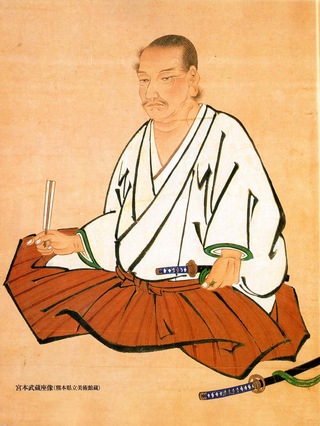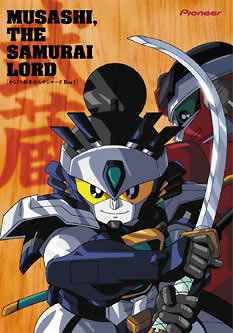Dorinbo (c. late 16th century) was a Japanese priest and the uncle of the famous swordsman Miyamoto Musashi during the 17th century in Edo period Japan. [1] He raised Musashi as a youth, and taught him basic knowledge of painting and religion.
Dorinbo (c. late 16th century) was a Japanese priest and the uncle of the famous swordsman Miyamoto Musashi during the 17th century in Edo period Japan. [1] He raised Musashi as a youth, and taught him basic knowledge of painting and religion.

Miyamoto Musashi, also known as Shinmen Takezō, Miyamoto Bennosuke or, by his Buddhist name, Niten Dōraku, was a Japanese swordsman, philosopher, strategist, writer and rōnin, who became renowned through stories of his unique double-bladed swordsmanship and undefeated record in his 61 duels. Musashi, as he was often simply known, is considered a Kensei, a sword-saint of Japan. He was the founder of the Niten Ichi-ryū, or Nito Ichi-ryū, style of swordsmanship, and in his final years authored The Book of Five Rings and Dokkōdō.

Vagabond is a Japanese epic martial arts manga series written and illustrated by Takehiko Inoue. It portrays a fictionalized account of the life of Japanese swordsman Musashi Miyamoto, based on Eiji Yoshikawa's novel Musashi. It has been serialized in Kodansha's seinen manga magazine Morning since September 1998, with its chapters collected into thirty-seven tankōbon volumes as of July 2014.

Sasaki Kojirō was a Japanese swordsman who may have lived during the Azuchi–Momoyama and early Edo periods and is known primarily for the story of his battle with Miyamoto Musashi in 1612, where Sasaki was killed. Although suffering from defeat as well as death at the hands of Musashi, he is a revered and respected warrior in Japanese history and culture. Later Miyamoto proclaimed that Sasaki Kojirō was the strongest opponent he faced in his life.

Mimasaka is a city located in Okayama Prefecture, Japan. As of 31 January 2023, the city had an estimated population of 25,946 in 12287 households and a population density of 60 persons per km². The total area of the city is 429.29 square kilometres (165.75 sq mi).
This is a list of fictional depictions of Miyamoto Musashi, the famous 17th-century Japanese swordsman.

Miyamoto Musashi Station is a passenger railway station located in the city of Mimasaka, Okayama Prefecture, Japan. It is operated by the third-sector semi-public railway operator Chizu Express. The station takes its name from the famous warrior Miyamoto Musashi, who was born nearby.

Musashi Miyamoto is a 1954 Japanese film by Hiroshi Inagaki starring Toshiro Mifune. The film is the first film of Inagaki's Samurai Trilogy of historical adventures.
Shinmen Sokan was a Japanese lord, daimyō of the Shinmen clan during the middle of the Sengoku period. Sokan was known as a rather petty daimyō in the mountainous regions of Sakushu, which was west of Kyoto. Even though this was so, the Shinmen clan had very good ties with that of the Hirata family, leading to the Shinmen receiving substantial support. One such swordsman of note that served under Sokan was the famous Shinmen Munisai, the father of the legendary swordsman Miyamoto Musashi. In 1589, Sokan ordered Munisai to kill Honiden Gekinosuke for unknown reasons. As a result, Munisai was forced to leave his village of Miyamoto.
Hayashi Shiryu was a notable swordsman during the Edo period of Japan. Shiryu originally was a student of the Hyōhō Niten Ichi-ryū style of swordsmanship before becoming a disciple under the famous Miyamoto Musashi. Before Shiryu had joined Musashi, he had dueled with him in a dojo. Musashi defeated him, in which he even lost consciousness after leaving the dojo. After reflecting on their duel, Musashi felt that Shiryu had shown considerable talent in the way he had fought, and thus his students took care of his recovery. Shiryu from then onward became a student under Musashi after he had completely recovered. After Musashi left the Owari region, Shiryu continued to study under the guidance of Takemura Yoemon, one of Musashi's senior students. After some time, Shiryu eventually received the final transmission of the Enmei ryu.
Takemura Yoemon was a swordsman during the Edo period of Japan. He was also possibly one of Miyamoto Musashi's adopted sons.
Hōjō Akinokami was a member of the Japanese clan of Hōjō during the Edo period of Japan, and kami of Aki province. It is thought that Akinokami and the famous Miyamoto Musashi were very close friends, or in a mutual discipleship. Throughout their many discussions together, Akinokami taught Musashi the ways of military strategy while the latter taught Akinokami of strategy reflecting individuality. However, this information is not truly well known because Akinokami would have been twenty-four years younger than Musashi, if born in the year 1608. If this discipleship was true, it is thought that Musashi looked at Akinokami as a master through the ways of politeness in view of the high position that Akinokami held. Doubts have also arisen through the fact that Musashi would have had his art of strategy complete by the age of fifty, and is therefore almost inconceivable that Akinokami could have been his teacher on the ways of strategy.
Ujii Yashirō a retainer under the Japanese clan of Hosokawa during the Edo period of Japan. Lord Hosokawa Tadatoshi had previously practiced the Yagyū Shinkage-ryū art of the sword, in which the principal sword master of the fief was none other than the renowned swordsman, Yashiro.
Shinmen clan was a Japanese kin group that flourished during the 15th–16th and 17th centuries of Japan. The clan resided in Western Kyoto. A Daimyo of the Clan was Shinmen Sokan.
Terao Motomenosuke was a famed swordsman during the Edo period of Japan. Motomenosuke would become rather famous for being the first successor to the School of Musashi that had been established by the legendary Miyamoto Musashi. When Musashi was aware of the fact that he was near death, he gave Motomenosuke both of his swords and a certificate of complete transmission. Motomenosuke later declined, and sent Musashi's swords and certificate to Miyamoto Iori thinking it would be more fitting. Iori replied to Motomenosuke saying, "I can be heir to the name and warrior's honor of Musashi, but I cannot take on the succession of his school. It is my wish that you, to whom Musashi passed on his art, succeed him. Please be kind enough to accept.". Thus, Motomenosuke accepted Musashi's request out of great respect and consideration toward his deceased master. Motomenosuke had a fourth son that he had seen potential within, a man by the name of Shinmen Bensuke whom he had later made the successor. Thus Motomenosuke would continue to expand the School of Musashi while reflecting great admiration towards his late master.
Terao Magonojō was a famed swordsman during the Edo period of Japan. Magonojo was the elder brother of Terao Motomenosuke, the successor to the School of Musashi. Magonojo has been noted as Miyamoto Musashi's favorite student, to whom Musashi entrusted his Gorin no sho before his death. Throughout Magonojo's early years working alongside Musashi, he trained with the kodachi, a type of short sword. On one occasion when they were training together, Musashi attacked Magonojo with a large wooden sword, which Terao parried with his short wooden sword and counterattacked. After several repetitions of this action, Terao's sword broke while Musashi was in the middle of striking his sword from above; however, Musashi's swing stopped just shy of hitting Terao's forehead. Magonojo received no injury, showing Musashi's skill with the weapon and high level of control. Before the death of Magonojo's master, he assumed the role of successor, which was subsequently passed on to his younger brother. It is thought that Magonojo burned the original Gorin no sho on Musashi's orders, because the complete original version cannot be found.
Jion (1351–1409) was a monk during the Nanboku-chō period of Japan. His full name was Nenami Okuyama Jion. Jion was the founder of the Nen ryu fighting style, famous for the simple saying "Strike with the left arm extended". During Jion's life, he trained fourteen disciples. Tsutsumi Hozan his 12th, was trained with the jitte fighting style and is said to have ripped off another disciples' jaw. Jion was strict about who would be the sharer of his teachings. Jion devised a system in which only one disciple could share the knowledge per fief. This was to make sure that Jion's influence would spread widely. Jion's fourteen disciples shared his teachings to fourteen different regions. Due to this, many famous swordsmen such as Kamiizumi Nobutsuna and Yagyu Muneyoshi learned Jion's teachings. Even the famous Miyamoto Musashi is said to have followed some of Jion's fighting principles.
Tsutsumi Hōzan (堤宝山), also known as Tsutsumi Yamashiro no kami Hōzan (堤山城守宝山), was a swordsman during the Sengoku period of Japan, who founded Hōzan ryū.
Tadashima Akiyama, also called Akiyama of Tajima, was a Japanese samurai of the Azuchi–Momoyama period who hailed from Tajima Province. A rather unknown figure, he is largely remembered for his defeat at the hands of the young Miyamoto Musashi, who was sixteen at the time. It has been concluded that Akiyama openly challenged Musashi.

Musashi, the Samurai Lord, known in Japanese as Karakuri Kengō Den Musashi Lord, is an anime series by Studio Pierrot. The 50-episode series aired on Nippon Television from October 1990 to September 1991.

The Miyamoto Musashi Budokan built in the province of Mimasaka in Ōhara-Cho cradle of Miyamoto Musashi was inaugurated on May 20, 2000 for the anniversary of his death. This budokan is dedicated to the official martial arts of Japan. It brings together all the saber and kendo traditional schools. All Japanese martial arts are called to this precinct, the heart of traditional Japan. This budokan achieves the unification of martial disciplines not only in practice but also historically and culturally. The inauguration took place in the presence of many Japanese officials including Sensei Tadashi Chihara guarantor and tenth of the line of Miyamoto Musashi, the mayor of Ōhara-Cho Fukuda Yoshiaki, Élisabeth Lamure mayor of Gleizé, and several saber and kendo schools representative of traditional and contemporary Japan.